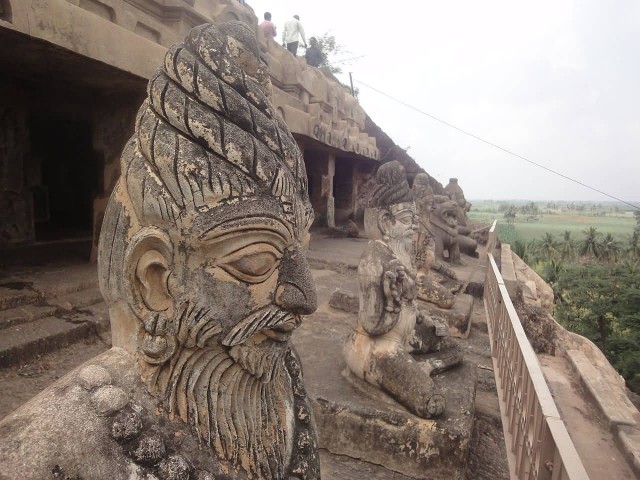Amazing Caves In India

Ananta Padmanabha Swami Temple (Photo Credit: Ramireddy.y / CC BY-SA 3.0)
Undavalli and Mogalarajapuram Caves, Andhra Pradesh

Storeyed Rock Cut Hindu Temple (Photo Credit: Rmuthuprakash / CC BY-SA 3.0)
The Undavalli Caves is a monolithic example of Indian rock-cut architecture and it is located in the village of Undavalli in the Guntur District and near the southern bank of the Krishna River in the state of Andhra Pradesh, India. The caves are located 6 km south west from Vijayawada and 22 km north east of Guntur City of Andhra Pradesh. These caves were carved out of solid sandstone on a hillside in the 4th to 5th centuries A.D. Undavalli caves are an example of how many Buddhist artifacts and stupas in Andhra were converted into Hindu temples and deities.

Undavalli Cave (Photo Credit: Chaitanya Vuddanti / CC BY-SA 3.0)
The Mogalarajapuram Caves are known for its five rock-cut sanctuaries that date back to around the 5th century. Located in city centre, these caves are now in ruins. The caves have religious significance due to the presence of the idols of Lord Nataraja and Lord Vinayaka in some of them. Besides the caves, the Mogalarajapuram Temple is also a prominent attraction.

View Of The Cave (Photo Credit: Naveenaparveen / CC BY-SA 3.0)
Elephanta Island Caves, Maharashtra

Elephanta Cave No. 1 (Photo Credit: Chinmaya Panda / CC BY-SA 3.0)
The Elephanta Caves are a network of sculpted caves located on Elephanta Island are a network of sculpted caves located on Elephanta Island in Mumbai Harbour, India. The island, located on an arm of the Arabian Sea, consists of two groups of caves the first is a large group of five Hindu caves and the second is smaller group of two Buddhist caves.

Elephenta Cave No. 3 (Photo Credit: Vaikoovery / CC BY 3.0)
The island is easily accessible by ferry from Mumbai. Boats leave daily from the Gateway of India, taking about an hour each way. There is also a narrow-gauge toy train from the boat area on the dock to the base of the steps leading up to the caves.

Smaller Cave In Elephanta (Photo Credit: Elroy Serrao / CC BY-SA 2.0)
Udayagiri and Khandagiri Caves, Orissa

Udayagiri Puri (Photo Credit: Xeteli/ Public Domain)
Udayagiri and Khandagiri Caves are partly natural and partly artificial caves of archaeological, historical and religious importance near the city of Bhubaneswar in Orissa, India.

Cave Monastry In Khandagiri (Photo Credit: Soumendra Barik / CC BY-SA 3.0)
The caves are situated on two adjacent hills Udayagiri and Khandagiri and it’s mentioned as Kumari Parvat. They have a number of finely and ornately carved caves. It is believed that most of these caves were carved out as residential blocks for Jain monks during the reign of King Kharavela. Udayagiri means “Sunrise Hill” and has 18 caves while Khandagiri has 15 caves.

Udayagiri Caves From Khandagiri (Photo Credit: Sourav Das / CC BY 2.0)
Badami, Karnataka

Badami (Photo Credit: Sudhir Kumar D / CC BY-SA 3.0)
Badami formerly known as Vatapi, is a town and headquarters of a taluk by the same name, in the Bagalkot district of Karnataka, India. It is famous for rock cut and other structural temples. It is located in a ravine at the foot of a rugged, red sandstone outcrop that surrounds Agastya lake. Badami is famous for its sandstone cave temples. A Buddhist cave in a natural setting that can be entered only by crawling on knees. Badami’s red sand stone cliffs are popular amongst local and international climbers. This is great location for free sport climbing and bouldering.

View Of Temples From Badami Caves (Photo Credit: Dineshkannambadi / CC BY-SA 3.0)
Ajanta and Ellora Caves, Maharashtra

Ajanta Caves Aerial View (Photo Credit: Freakyyash / CC BY-SA 3.0)
The Ajanta Caves in Aurangabad district of Maharashtra, India are about 30 rock-cut Buddhist cave monuments. The caves include paintings and sculptures described by the government Archaeological Survey of India as “the finest surviving examples of Indian art, particularly painting”.

Ellora Cave No. 21 (Photo Credit: Nandanupadhyay / CC BY-SA 3.0)
The Ajanta caves are cut into the side of a cliff that is on the south side of a U-shaped gorge on the small river Waghur. Well known for its monumental caves, Ellora is a World Heritage Site. Ellora represents the epitome of Indian rock-cut architecture. The 34 “caves” are actually structures excavated out of the vertical face of the Charanandri hills. Ellora is known for Hindu, Buddhist and Jain cave temples.

Ajanta Caves (Photo Credit: Wikipedia / CC BY-SA 3.0)















